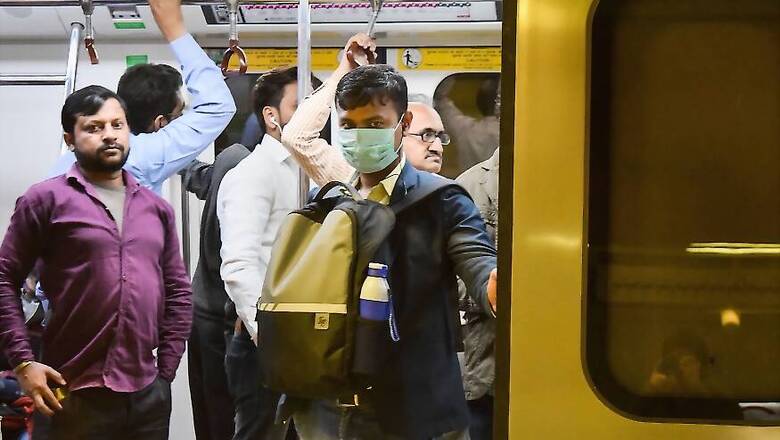
views
New Delhi: Schools, colleges, multiplexes, malls, gyms and swimming pools across several states have been shut till 31 March. The idea is to avoid mass gatherings at a time when more than 100 positive cases of coronavirus have been detected in the country.
However, it is not easy to completely isolate yourself especially when one needs to manage a house, be at work or even go about the day in a healthy manner without putting others at risk.
The Centers for Disease Control and Prevention, a leading public health institute in the US, issued guidelines for “community mitigation strategies” to limit the spread of what has already been declared a pandemic.
The instructions include recommendations for “social distancing”. Many experts think that is the best way to break potential chains of transmission by preventing infected people from coming in close contact with healthy ones.
Almost every guideline issued by various institutions have clearly asked citizens to not panic. News18 explains how to limit social exposure without severely affecting your daily routine.
What is Social Distancing?
Social distancing is a term that epidemiologists use to refer to a conscious effort to reduce close contact between people in the hope to prevent community transmission of the virus.
According to global health experts, social distancing measures can be revved up or moderated according to the situation prevalent locally.
What is Flattening the Curve?
Flattening the curve refers to using protective practices to slow the rate of COVID-19 infection so that hospitals have rooms, supplies and doctors for all those who need care.
Simply put, a large number of people becoming sick over the course of a few days could overwhelm a hospital or care facility. With more people expected to become severely ill due to COVID-19 at approximately the same time, a situation may arise when there could be a shortage of hospital beds, equipment or doctors.
When plotted on a graph, the sudden spike in the number of patients in a short span of time would result in a steep and narrow curve. However, if the same number of patients arrived over a longer span of time, essentially at a slower rate, the graph would look like a longer, flatter curve.
This would mean lesser patients every day and a better chance of the hospital being able to keep up with adequate supplies, beds and health care.
Do Visits to Old Relatives Need to be Avoided for Now?
Global health experts said citizens should start limiting visits to people who are in assisted-living facilities and nursing homes. Moreover, health guidelines prescribed that people aged over 60 years must limit their social contact to the "absolutely unavoidable."
Are Common Spaces in Housing Societies a Problem?
Any place that has the potential to host a large gathering is being considered a potential risk. At best, one can visit these places when the crowd expected is minimal.
Even if You're Symptom-Free, Should Places Like a Restaurant be Avoided?
The best option is to stay at home. However, one can visit places where not too many people are expected. China and South Korea have taken extreme measures to execute social distancing which, they claim, have resulted in bringing the rate of transmission down.
If Not Eating Out, Are House Parties an Option?
As long as none of the guests have symptoms that could potentially be leading to transmission, gatherings in private, closed premises are not be worried about. However, in the event of close contacts developing any of the COVID-19 symptoms, the party needs to be called off.
What about Dates?
Almost every guideline instructs against large gatherings, not so much about one-on-one interactions. However, News18 reported several cases in India where people are cancelling their dates due to the pandemic scare.
Albert Ko, the chair of the epidemiology department at the Yale School of Public Health, told the Atlantic that dating is usually one person and another person. "What we’re really worried about in terms of public health are these large gatherings where you have people crowded together. Dating is at the other end. I think you can still date."
Grocery Stores Are a Necessity, How To Avoid People There?
Health experts recommended trying to shop at times when there are lesser shoppers. The other option is to rely on mobile applications that provide the facility to home-deliver groceries.
Not Everyone Has Car and Bike, How Safe is Public Transport?
In order to address this very concern, several offices in India have asked their employees to start working from home relieving them from the need to travel to work daily.
However, for those who cannot miss work, travelling at non-peak hours can be an option. Metro rides in New Delh, for example, have seen decline in foot-fall at what is colloquially referred to as "office-hours."
Several media reports have stated that people are consciously not touching support bars and rims in order to stay safe. Opting for ride-sharing services may also be considered
For How Long Should Social Distancing be Practised?
While countries in the past have implemented social distancing and been able to reduce the number of cases, past experiences suggest that once the restrictions are lifted, the outbreak can resurge. Therefore, unless medically advised, citizens have been advised to avoid all places of mass gatherings.
What is the Best Way to Go Out Safely Without Putting Others at Risk?
The World Health Organisation recommend several basic measures to help prevent the spread of COVID-19:
- Wash your hands often for at least 20 seconds.
- Cover your cough or sneeze with a tissue, then throw the tissue in the trash.
- Clean and disinfect frequently touched objects.
- Stay home when you are sick.
- Contact a health worker if you have symptoms; fever and a dry cough are most common.
- Do not touch your face.
- Do not travel if you have a fever and cough.
- Do not wear a face mask if you are well.




















Comments
0 comment